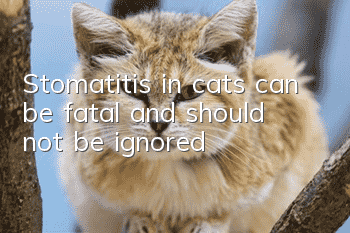Stomatitis in cats can be fatal and should not be ignored!

"Stomatitis" sounds like a very trivial disease, and it is also a hidden disease risk that many people tend to ignore. When a cat suffers from stomatitis, it should not be taken lightly, as severe cases can be fatal.
Stomatitis is not ordinary periodontitis, but an inflammation of the cat’s oral cavity.
Especially when cats are eating, they often salivate a lot, and some shake their heads and whine while eating. This is a reaction to food stimulating pain points. Cats suffering from stomatitis usually have difficulty eating, their gums are swollen, ulcerated or even eroded, and their tongues sometimes spit out because of the pain of putting them in their mouths, which looks very painful.
When I was at the pet hospital, a cat was about to die because of severe stomatitis that could not be cured. Its owner did not choose euthanasia and could only watch it pass away. I really felt helpless at that moment. If the stomatitis had been discovered earlier, it would not have been so miserable.
Therefore, all poop scrapers must pay attention to the oral problems of cats, take preventive measures, and treat them in advance to avoid them from becoming more serious.
The cause of feline stomatitis is still unclear. Punctures, burns, accidental ingestion, decreased immunity, periodontal and dental diseases, nutritional deficiencies, etc. in cats’ oral cavity may all cause feline stomatitis. But we can judge the condition of the cat’s oral cavity through the cat’s reaction.
Symptoms of stomatitis
When cats have the following symptoms, owners should pay special attention!
1. No more licking
2. Oral odor and drooling
3. Dropping food
4. Wailing when eating and even unwilling to eat
5. Weight loss
Cats in the early stages of the disease During oral examination, you will find that the gums and oral mucosa are red, swollen and inflamed. The gums and oral mucosa will show redness and tissue proliferation.
Some cats will exhale foul-smelling gas, drool severely, and secrete white foam from the corners of their mouths. Severe cats will develop vesicular stomatitis, which means blisters of varying sizes appear on the oral mucosa. More severe cats will have rot, necrosis, erosion, half-protruding tongue, hoarse voice, etc. in the oral mucosa.
How to treat stomatitis
When faced with cat stomatitis, scavengers must be mentally prepared for a long-term struggle. First, the hospital will check to confirm the cause and rule out whether it is a viral infection.
Viral infection: If caused by a virus, you need antiviral treatment, interferon, and Kelu oral spray.
Non-viral infection:
1. Remove foreign objects, dental calculus, broken teeth, etc. from the oral cavity. And improve feeding habits and feed some liquid or easy-to-chew food. Avoid feeding dry or ground cat food to your cat to prevent further infection.
2. You can use Vick Pet Mouthwash to clean your mouth every day. If it is ulcerative stomatitis, you can use more supplements of vitamin B complex and vitamin C.
3. Antibiotic therapy can also be used, such as amoxicillin, Sono, Demi, etc.
4. If it cannot be controlled, full tooth extraction is required. Some fans asked me if I could only extract the diseased teeth. In fact, as long as teeth need to be extracted, I have to extract all the teeth, otherwise the disease will continue.
How to prevent stomatitis
Hit the key points!!
Stomatitis is a very painful disease for cats. We must take precautions and let cats say no to stomatitis!
1. Pay attention to your diet. Do not give oily or salty food and choose high-quality cat food.
2. Daily oral care. Brush your cat’s teeth on time, usually 3 times a week.
3. Ensure adequate vitamin intake.
4. Regular inspection. Check your cat’s mouth for inflammation.
5. Get timely treatment. If your cat has symptoms of stomatitis or is carrying the stomatitis virus, it should go to the hospital for treatment in time.
Before raising a cat, please make sure that you have the time and energy to take care of it. Don't throw it away on a whim. Love it and don't hurt it.
- What does it mean when a cat meows while looking at you?
- Treatment of jaundice hepatitis in cats, treatment principles of feline hepatitis!
- How to clean scabs from cat eye feces
- Can I bathe a two-month-old kitten if it smells bad?
- What are the reasons why blue cats shed a lot of hair?
- Can cats eat boiled shrimp every day?
- How to treat ear mites in cats? Officers must persist!
- How many times a day is it normal for a cat to defecate?
- How often should pet cats take deworming medicine?
- Can newborn kittens drink soy milk powder?



